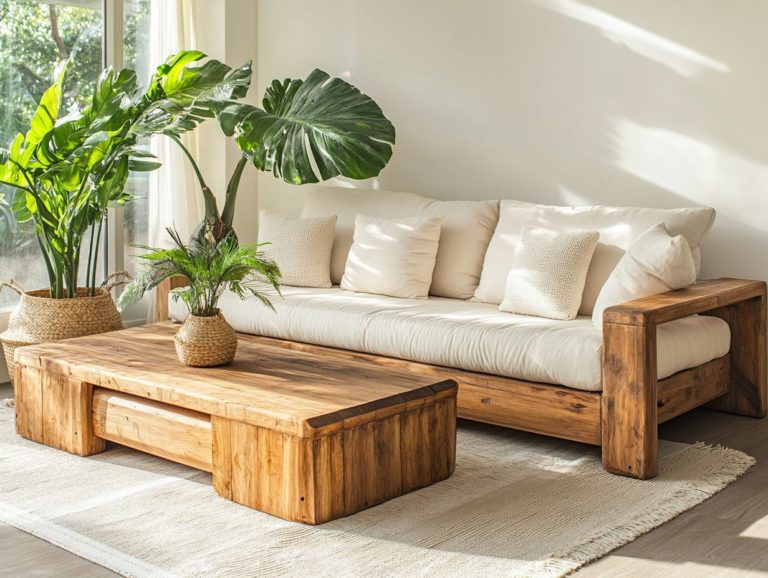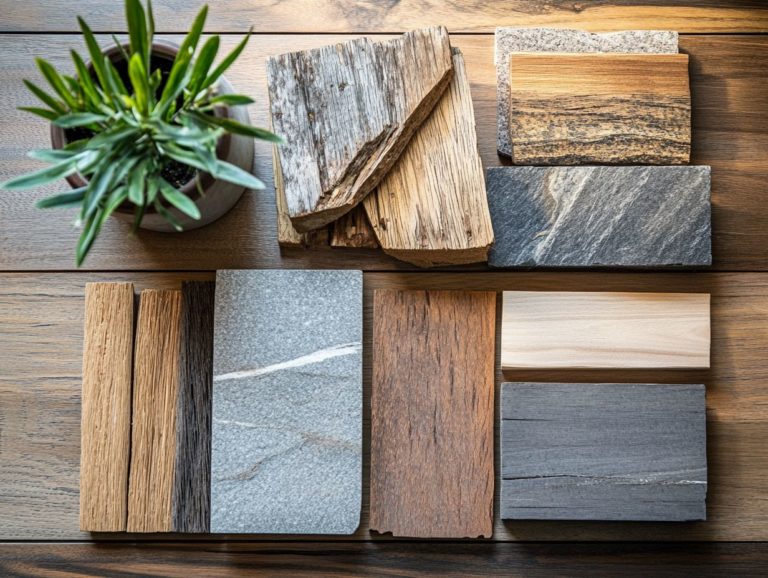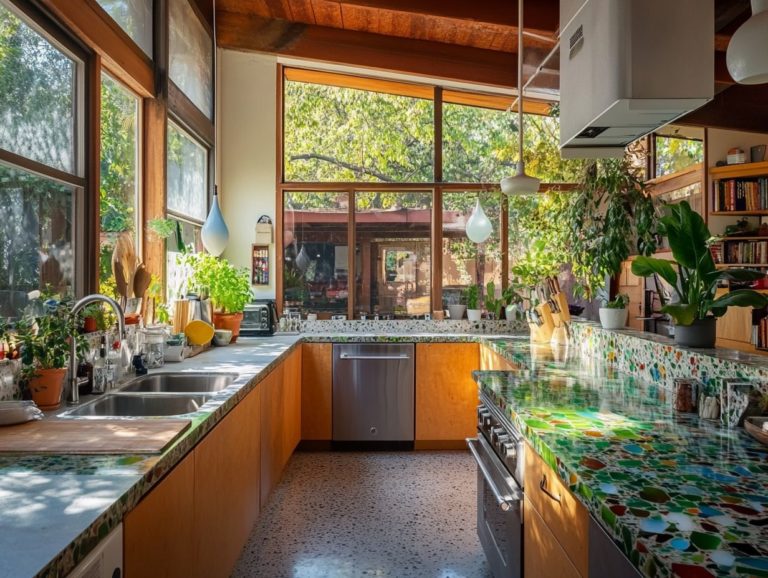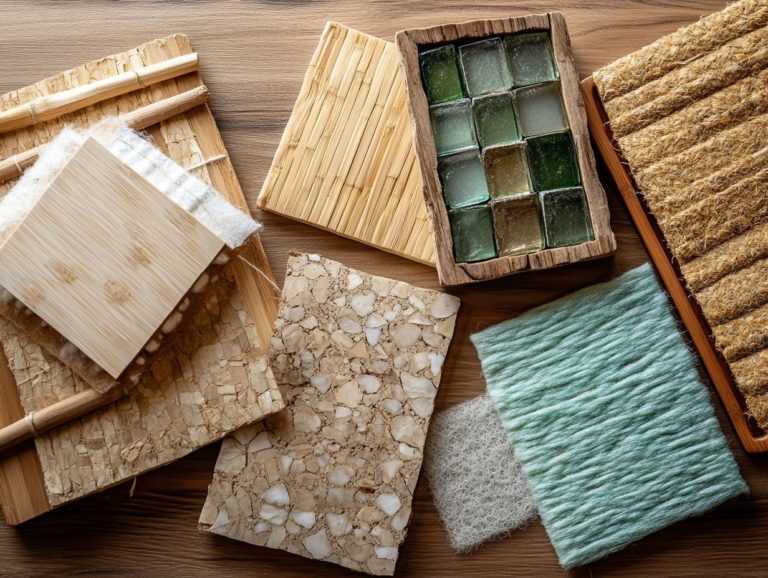Sustainable Interior Design Ideas for Every Room
Sustainable interior design goes beyond trends. It fosters healthier homes and a vibrant planet.
With eco-friendly materials and energy-efficient appliances at your disposal, each room becomes an opportunity to weave sustainability seamlessly into your living environment.
Delve into innovative design ideas for your living room, kitchen, bathroom, bedroom, home office, and outdoor spaces.
Uncover ways to elevate your home s aesthetic while placing the environment and your well-being at the forefront of your design choices.
Let’s transform your living space into a vibrant eco-friendly sanctuary today!
Contents
- Key Takeaways:
- The Importance of Sustainable Interior Design
- Living Room Design Ideas
- Kitchen Design Ideas
- Bathroom Design Ideas
- Bedroom Design Ideas
- Home Office Design Ideas
- Outdoor Design Ideas
- Frequently Asked Questions
- What is sustainable interior design?
- Why is sustainable interior design important?
- What are some sustainable interior design ideas for the living room?
- How can I make my bedroom more sustainable?
- Are there sustainable interior design options for small spaces?
- Can I incorporate sustainable design in my kitchen?
Key Takeaways:

- Incorporating sustainable design elements into your home can benefit both the environment and your health.
- From using eco-friendly appliances in the kitchen to water and energy conservation techniques in the bathroom, there are many ways to make every room in your home more sustainable.
- When designing your home office and outdoor space, consider using eco-friendly furniture, lighting, and natural elements to create a sustainable and inviting atmosphere.
The Importance of Sustainable Interior Design
Sustainable interior design is increasingly recognized as a vital approach for creating homes that are good for the environment and our health.
By integrating sustainable materials, eco-friendly practices, and mindful consumption, you contribute to healthier environments that enhance both well-being and aesthetic appeal.
This design is all about cutting down on waste and using natural materials, which promotes harmony with nature.
As you celebrate initiatives like World Earth Day, the significance of sustainable design in modern interiors becomes clear, shaping a landscape that values both beauty and sustainability.
Benefits for the Environment and Your Health
Embracing sustainable interior design practices offers remarkable advantages for both the environment and your well-being. It creates eco-friendly homes that significantly enhance indoor air quality and overall health.
By integrating elements like energy-efficient appliances and sustainable materials, you can reduce energy consumption while cultivating a more comfortable living space.
Using natural cleaning products lessens your exposure to harmful chemicals, promoting better respiratory health for everyone in your home. Prioritizing organic fabrics and non-toxic paints contributes to a cleaner atmosphere, greatly improving indoor air quality.
These mindful choices not only demonstrate your commitment to the planet but also foster a sense of tranquility and wellness. Sustainable design represents a transformative lifestyle that aligns beautifully with modern sensibilities.
Living Room Design Ideas
In the realm of living room design, embracing sustainable interior design elements elevates the aesthetic of your space while seamlessly aligning with eco-friendly choices that foster a healthier lifestyle.
Using Sustainable Materials and Energy-Efficient Features
Incorporating sustainable materials and energy-efficient features into your living room can elevate the space while significantly reducing your environmental impact.
Consider using reclaimed wood; it adds character and warmth to your home while promoting recycling and minimizing waste.
Bamboo partitions are another fantastic option, bringing a fresh aesthetic to your room while being highly renewable. Decor crafted from recycled materials can introduce unique style elements without sacrificing quality.
Pairing these materials with energy-efficient appliances transforms your living area into a space that is both functional and environmentally friendly.
Opting for low-VOC paints enhances air quality, making your living room more inviting and comfortable. By embracing these choices, you create a harmonious blend of style and sustainability, showcasing your commitment to a greener lifestyle.
Kitchen Design Ideas
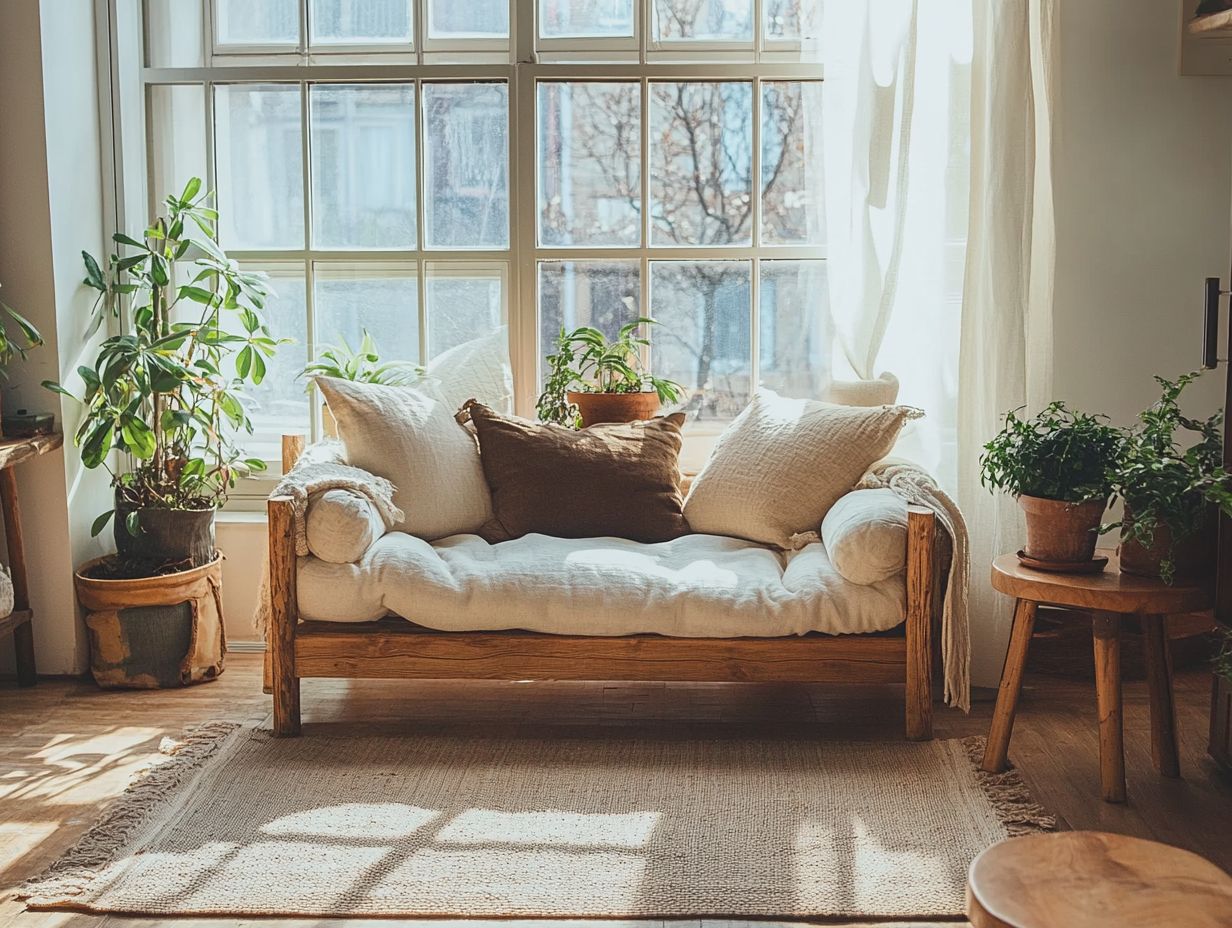
Designing a sustainable kitchen means choosing eco-friendly appliances and integrating natural materials. This enhances the kitchen’s beauty while championing sustainable practices.
This smart choice not only transforms your space into a stylish haven but also reflects a commitment to environmental responsibility.
Eco-Friendly Appliances and Practices
To create an environmentally-friendly kitchen, select eco-friendly appliances and adopt sustainable practices. These choices genuinely minimize your carbon footprint.
Start by choosing energy-efficient refrigeration options, like models with ENERGY STAR ratings. These appliances consume less electricity while ensuring your food stays fresh.
Incorporating induction cooktops can elevate your energy efficiency. They heat up more quickly and use less energy compared to traditional gas burners.
For lighting, opt for sustainable solutions like LED bulbs. These can significantly reduce your energy consumption.
You can also practice habits like composting organic waste and using reusable containers for food storage. This not only cuts down on waste but also supports your commitment to reducing your overall environmental impact.
Bathroom Design Ideas
Transforming your bathroom into a sustainable oasis requires embracing water conservation techniques. Incorporate eco-friendly products that elevate both functionality and aesthetic charm.
This thoughtful approach conserves resources and creates a serene environment that reflects your commitment to sustainability.
Water and Energy Conservation Techniques
Water and energy conservation techniques are essential for crafting a sustainable bathroom. Focus on eco-friendly products and energy-efficient fixtures that reduce resource consumption.
By incorporating low-flow faucets and showerheads, you can significantly cut down on water use. Enjoy the performance and comfort without compromise.
Selecting energy-efficient lighting options, like LED bulbs, minimizes your electricity consumption while enhancing the aesthetic of the space.
Don’t overlook the benefits of installing dual-flush toilets. These toilets allow you to choose between different water volumes for liquid or solid waste, promoting wise water use.
By embracing these practices, you foster a more sustainable lifestyle that aligns your daily routines with broader environmental goals.
Bedroom Design Ideas
Crafting a serene and sustainable bedroom oasis requires a thoughtful selection of eco-friendly materials and vintage decor. Focus on design choices that maximize natural light and foster an atmosphere of tranquility.
Creating a Relaxing and Sustainable Space
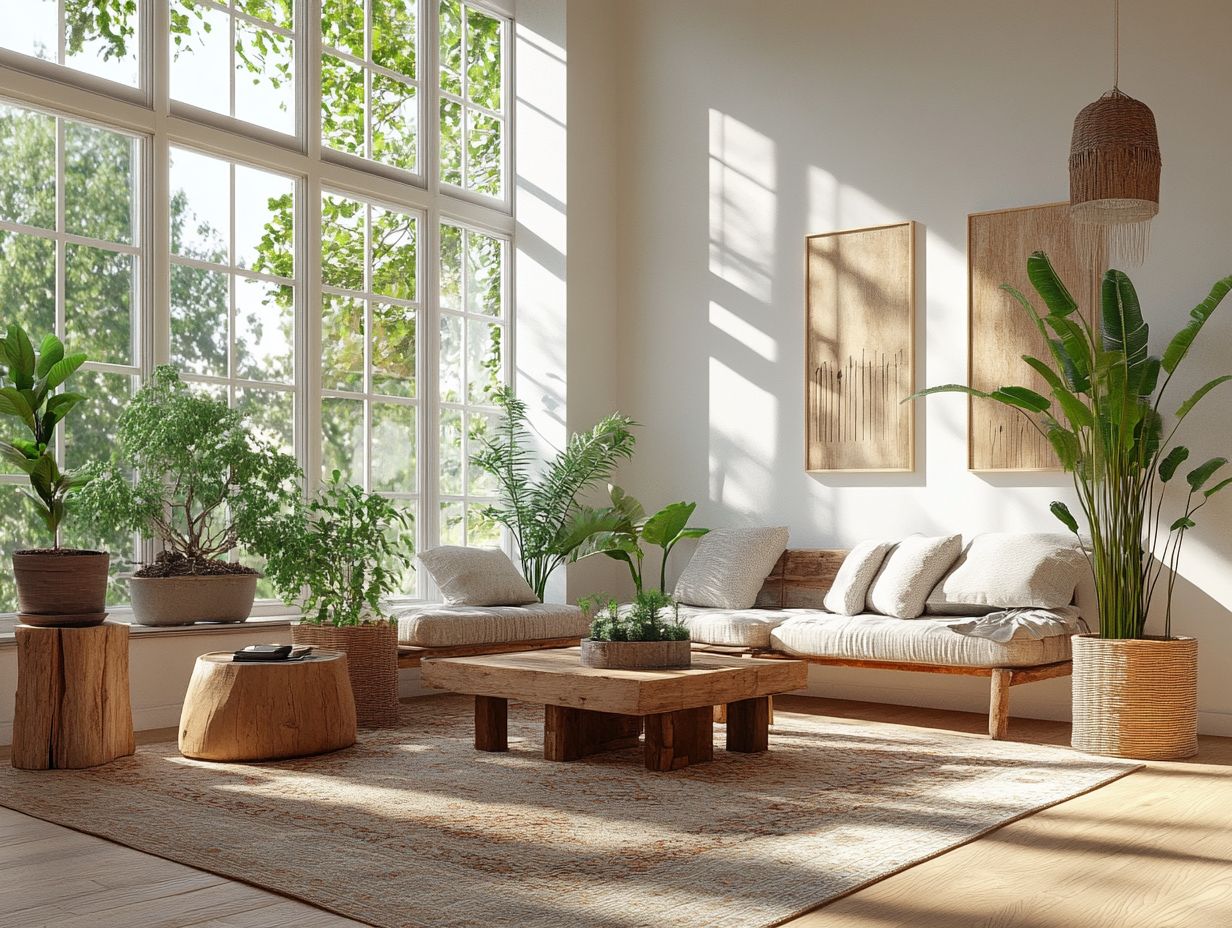
Create a relaxing and sustainable bedroom by incorporating eco-friendly materials, vintage furnishings, and mindful choices. These enhance indoor air quality.
Choosing natural fibers like organic cotton and linen for your bedding transforms the space into a soft, inviting haven that encourages restful sleep.
Embracing a minimalist design declutters your surroundings and cultivates a tranquil atmosphere. This allows your mind to unwind.
Incorporating vintage pieces adds charm while promoting a cycle of reuse that benefits the planet.
By opting for eco-friendly paint and paints with fewer harmful chemicals, you ensure a healthy indoor environment that supports your overall well-being.
Together, these elements create a peaceful sanctuary that nurtures both your body and mind.
Home Office Design Ideas
When designing a home office that emphasizes sustainability, consider incorporating eco-friendly furniture and energy-efficient lighting. This thoughtful approach enhances your productivity and cultivates an environmentally conscious workspace that reflects your values.
Eco-Friendly Furniture and Lighting Options
Choosing eco-friendly furniture and energy-efficient lighting is essential for creating a sustainable home office that embodies style and environmental responsibility.
When you select pieces crafted from reclaimed wood, bamboo, or recycled materials, you not only lessen your carbon footprint but also add unique character and charm to your workspace. Consider options like ergonomic desks made from sustainable materials and chairs designed with recycled plastics. These choices significantly enhance your comfort while elevating the overall aesthetics of your office.
Incorporating LED lighting solutions cuts down on energy consumption and creates a warm ambiance that fosters productivity. Embracing eco-conscious choices transforms your home office into a sanctuary of creativity, showcasing your commitment to personal well-being and the planet.
Outdoor Design Ideas
Integrating natural elements and sustainable landscaping into your outdoor design cultivates comfortable outdoor areas that connect you to nature and champion eco-friendly practices. This smart approach transforms your backyard into a beautiful retreat!
Utilizing Natural Elements and Sustainable Landscaping
Transform your outdoor space into an eco-friendly sanctuary that enhances aesthetics and environmental well-being by using natural elements and sustainable landscaping techniques.
Incorporating native plants and locally sourced materials, like stone, creates a harmonious environment that supports local wildlife while minimizing reliance on chemical fertilizers and pesticides.
Implementing rain gardens and permeable pathways effectively manages stormwater runoff and promotes groundwater recharge. Choosing natural wood for decks or garden structures introduces warmth and organic texture to your space while also reducing your carbon footprint.
By emphasizing biophilic design which connects people with nature you cultivate a serene atmosphere that nurtures both your mind and the ecosystem.
Frequently Asked Questions

What is sustainable interior design?
Sustainable interior design is an approach to creating living spaces that are environmentally friendly, socially responsible, and economically viable. It involves using materials and techniques that minimize harm to the planet while promoting health and well-being for both humans and the environment.
Why is sustainable interior design important?
Sustainable interior design is crucial as it helps reduce the negative impact of traditional practices on the environment. It also promotes healthier living spaces and supports social responsibility by considering the well-being of workers involved in the production of materials.
What are some sustainable interior design ideas for the living room?
- Use natural and renewable materials like bamboo or reclaimed wood for furniture.
- Incorporate energy-efficient lighting.
- Choose non-toxic and eco-friendly paints and fabrics for upholstery and curtains.
How can I make my bedroom more sustainable?
You can make your bedroom more sustainable by choosing organic and sustainable materials for bedding and furniture, opting for energy-efficient lighting, and incorporating plants to improve air quality. Upcycle old furniture today to give your space a unique touch!
Are there sustainable interior design options for small spaces?
Yes! There are many sustainable interior design options for small spaces. You can:
- Use multipurpose furniture to save space.
- Choose energy-efficient appliances.
- Incorporate natural light to reduce the need for artificial lighting.
- Utilize sustainable storage solutions, such as using recycled materials for shelves or containers.
Got more questions? Reach out to us for personalized advice on making your space sustainable!
Can I incorporate sustainable design in my kitchen?
Absolutely! There are many ways to incorporate sustainable design in the kitchen.
Transform your kitchen into an eco-friendly haven! Consider using energy-efficient appliances and selecting natural materials for countertops and cabinets. Composting food waste is another great idea. You can also add plants and herbs for a fresh touch.

